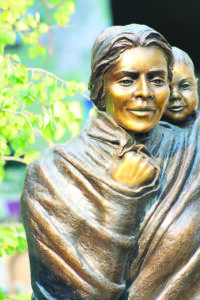
by John Dowd
One of the greatest American stories of heroism, adventure and exploration is undoubtedly that of the Lewis and Clark Expedition. This was an expedition that likely would not have seen its famed success without the help of one young woman and much serendipity.
Just a year after the Louisiana purchase, then president Thomas Jefferson acquired nearly 830,000 acres of land west of the Mississippi. This land needed to be explored for the country to be fully aware of what it now had. The decision was a risky one on Jefferson’s part. However, it would become something he would utilize to further the country, and to turn his campaigns around into a positive light. In order to do this, he commissioned an expedition that could be equivalently compared to the challenges of setting a man on the moon. Jefferson contracted a young man who was a family friend and personal secretary. The young man’s name was Meriwether Lewis.
Lewis hailed from a difficult moral background and found rigidity in service under the tutelage of a superior officer with whom he would develop a deep and lasting friendship. A superior officer who he would not take on such an expedition without. The officer’s name was Second Lieutenant William Clark. As is unusual in military service, both men would attend the expedition with equal perceived rank to the men. Though Lewis was in fact captain, both men would be addressed as such for the mission.
The two would co-lead the adventure, and were joined eventually by a total of 43 souls. These would include 38 enlisted men, a boat crew, a French-Indian interpreter and his wife and Clark’s lifelong friend and slave, York. Ahead of them was nearly 4,000 miles of terrain that had only been seen by a handful of white men. In fact, the land was so unknown, that even Jefferson subscribed to the idea that there may be still-living woolly mammoths on the plains, or among the mountains to the west.
Lewis himself went through nearly a year of sped-up training to get him ready for the adventure. The man was considered a genius at the time, and was taught everything from cartography, to plant identification and survival to engineering. Lewis’s crash course on exploration was only one of many aspects of the expedition that would lead to its success. However, the main lynchpin that would save the party many times would come down to a young Shoshone woman by the name of Sacajawea.
On Monday, June 26, 2023, at the Darby Sacajawea’s Rest Park, at 10:30 a.m. representatives of the Salish and Shoshone, including the descendant niece of Sacajawea, will be present to receive an official thank you for just such an occasion. The particular occasion was one of the major make-or-break events during the expectation. In August of 1805, the expedition was in dire straits. They needed horses and help finding the way to the Pacific through the treacherous Rockies. Through a chance encounter, the expedition made contact with the Shoshone, whose chief was by complete chance, and unbeknownst even to her, Sacajawea’s long lost brother. The young girl had been kidnapped in her early teens and taken away for a life with tribes on the great plains. Cameahwait, Sacajawea’s brother, traded horses that they were not in a great position to give in the first place, and what was given was not enough to survive the entire trip with. However, some horses is better than no horses.
In September of 1805, the expedition was making their way over a pass with the horses when they found themselves on such a steep grade that many horses fell. With several stricken lame, the party had a second chance encounter with another tribe, the Salish. The area is referred to today as Ross’ Hole, and is located near modern Sula, in Ravalli County. The Salish were encamped there and saved the party again, giving them plenty of horses and trading straight across for the lame horses.
The event on Monday, June 26 will be, according to local Lewis and Clark expert, Ted Hall, “the first time that I know of, where a tribe will be officially thanked for bailing out the United States military.”
Even after all the training, money and equipment that the, at the time, modern U.S. military had poured into an operation, the success was ultimately dependent on chance, courage and the ancestry of a young woman that was brought along. And that was just a couple of the times, within only a few weeks, that these things made the difference along the nearly two-and-a-half year long journey.